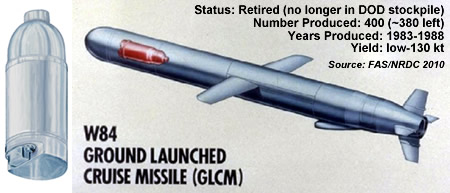 |
| The compact W84 warhead (left) was designed to be delivered by the ground-launched cruise missile. Some 380 W84s are awaiting dismantlement – or reuse. |
.
By Hans M. Kristensen
The National Nuclear Security Administration (NNSA) recently announced that disassembly of the W84 warhead has begun at the Pantex Plant in Texas.
This marks the final phase for a group of 400 warheads that were at the center of the Cold War in Europe as part of NATO’s Double Track Decision in 1979 to deploy intermediate-range weapons in response to Soviet deployments. The W84 armed the Ground-Launched Cruise Missile (GLCM) that was eliminated by the 1987 INF Treaty.
Redundant before production was completed in 1988, the W84 spent the rest of its life on shelves in military warehouses in the United States. The NNSA press release states that the W84 “remains in the inactive stockpile,” but the weapon was formally retired in 2006-2007, and neither the DOE budget request for FY2011 nor the latest Stockpile Stewardship Management Plan (SSMP) lists the W84 as part of the DOD stockpile. NNSA told me they would correct the press release.
The W84 was and probably is the safest of all the warhead types produced by the United States. It is equipped with more safety and security (surety) features than any other warhead: Insensitive High Explosives; Fire Resistant Pit; Enhanced Nuclear Detonation Safety (ENDS/EEI) with detonator stronglinks; Command Disable; and the most advanced Permissive Action Link (PAL G).
| Relative Surety of U.S. Nuclear Warheads |
 |
| The W84 is the equipped with more safety and security features (surety combined) than any other warhead in the U.S. stockpile. The W84 was retired in 2006-2007. |
.
It may seem as an irony that the safest warhead is being scrapped at a time when the administration is asking Congress to authorize billions of dollars to increase the safety and security of the remaining warheads in the stockpile. But there is a twist.
A few years ago, dismantlement at Pantex would have meant the end for the W84. But the Obama administration’s Nuclear Posture Review decided that the “full range of LEP approaches will be considered: refurbishment of existing warheads, reuse of nuclear components from different warheads, and replacement of nuclear components.”
As a result, the W84 – and all other retired warheads currently in line for dismantlement – “will be assessed for reuse applications as appropriate,” NNSA told me.
Therefore, they said, “it would be premature to assume that components from the W84 operations will be for immediate disposal (scrapping).”
So who knows, one day the W84 – or components of it – might be deployed once again as part of a replacement warhead.
This publication was made possible by a grant from Carnegie Corporation of New York and Ploughshares Fund. The statements made and views expressed are solely the responsibility of the author.
While it is reasonable for governments to keep the most sensitive aspects of nuclear policies secret, the rights of their citizens to have access to general knowledge about these issues is equally valid so they may know about the consequences to themselves and their country.
Nearly one year after the Pentagon certified the Sentinel intercontinental ballistic missile program to continue after it incurred critical cost and schedule overruns, the new nuclear missile could once again be in trouble.
“The era of reductions in the number of nuclear weapons in the world, which had lasted since the end of the cold war, is coming to an end”
Without information, without factual information, you can’t act. You can’t relate to the world you live in. And so it’s super important for us to be able to monitor what’s happening around the world, analyze the material, and translate it into something that different audiences can understand.